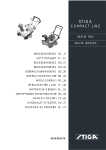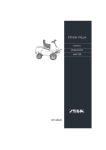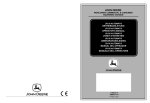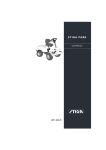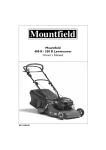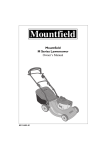Download Mountfield 2105M Instruction manual
Transcript
2105M - 2125H BRUKSANVISNING ISTRUZIONI PER L’USO KÄYTTÖOHJEET INSTRUCCIONES DE USO BRUGSANVISNING INSTRUÇõES DE UTILIZAÇÃO BRUKSANVISNING INSTRUKCJA OBS£UGI GEBRAUCHSANWEISUNG »HC“P”K÷»fl œOÀ‹«Œ¬¿“EÀfl INSTRUCTIONS FOR USE NÁVOD K POU®ITÍ MODE D’EMPLOI HASZNÁLATI UTASÍTÁS GEBRUIKSAANWIJZING NAVODILA ZA UPORABO 8211-0411-01 1 S SVENSKA 2 J F K G B A H D E C I 3 4 5 6 F I G H G S 7 J K C D, E S SVENSKA 8 4 3 2 1 5 9 6 10 7 9 8 11 12 S 13 15 SVENSKA 14 16 0,7 - 0,8 mm 17 18 ENGLISH GENERAL This symbol indicates WARNING. Personal injury and/or damage to property may result if the instructions are not followed carefully. You must read these instructions for use and the accompanying pamphlet “SAFETY INSTRUCTIONS” carefully, before starting up the machine. SYMBOLS The following symbols appear on the machine. They are there to remind you of the care and attention required in use. This is what the symbols mean: Warning! Read the instruction manual and the safety manual before using the machine. Warning! Watch out for discarded objects. Keep onlookers away. Warning! Always wear hearing protectors. Warning! This machine is not designed to be driven on public roads. GB machine. • Before use, all drivers must apply for and receive practical training in the operation of the machine. Particular emphasis should be placed on the fact that: a. The use of ride-on lawnmowers requires care and concentration. b. On slopes, it is not possible to control a sliding ride-on lawnmower by braking. The main reasons for losing control are insufficient traction, excessively high speed, insufficient braking, the machine not being suited to the task, lack of attention to the surface or incorrect use as a towing vehicle. • Never let children or anyone who is not familiar with these instructions to use the machine. Local regulations may impose restrictions as regards the age of the driver. • Never use the machine if others, particularly children or animals, are in the vicinity. • Remember that the driver is responsible for accidents that happen to other people or their property. • Do not let children or other passengers to ride with you on the machine. They might fall off and be seriously injured, or they might prevent the machine being driven safely. • Do not use the machine if you are under the influence of alcohol, drugs or medication. Neither should you use it when you are tired or feeling unwell. Warning! The machine, equipped with original accessories, may not be driven on slopes greater than 10º in any direction. PREPARATIONS Warning! Risk of burn injuries. Do not touch the silencer. • Wear strong shoes and long trousers when using the machine. Do not operate it barefoot or wearing sandals. This machine is available in two versions. • manual transmission, designated 2105M. • hydrostatic transmission, designated 2125H. SAFETY INSTRUCTIONS GENERAL • Please read through these instructions carefully. Learn all the controls and the correct use of the • Wear appropriate clothing when using the machine. Do not wear loose, hanging clothes, jewellery, scarves, ties, etc., which can get caught in rotating parts. Tie up long hair. • Carefully check the area that is to be cut/cleared of snow. Remove all loose stones, sticks, steel wire and other foreign objects which the machine could throw out. • Warning – Petrol is highly inflammable. a. Always store petrol in containers that are made especially for this purpose. 5 GB ENGLISH b. Only fill or top up with petrol outdoors, and never smoke when filling or topping up. c. Fill with petrol before starting the motor. Never remove the filler cap or fill with petrol while the engine is running or still warm. d. If petrol is spilt, do not try to start the engine but instead move the machine away from the place where the spillage occurred and avoid any possible causes of sparks until the petrol fumes have evaporated. e. Do not forget to screw the cap on the petrol tank and the storage container after filling. • Replace faulty silencers. • Before use, always check that blades and mounting devices are not worn or damaged. Replace worn or damage parts as a set so that the correct balance is maintained. • The battery (on electrically started machines) gives off explosive gases. Keep sparks, flames and cigarettes away. Ensure there is sufficient ventilation during charging. • The battery contains toxic material. Do not damage the battery casing. If the casing is damaged, avoid contact with the content of the battery. • Do not throw out old, defective batteries with the rubbish. Contact the local authorities for correct waste management. • Do not short circuit the battery. Sparks occur which can result in fire. DRIVING • Start the engine according to the instructions in the user guide. Keep your feet away from the blades. both before and during reversing to check for any obstacles. Look out for small children. • Disengage the blade(s) and the connection before starting the engine. • Never have your hands or feet near or under rotating parts. Watch out for the blades. Do not stand right in front of the discharge opening. • Avoid using the machine on wet lawns. • Be careful when driving on slopes. No sudden starting or stopping when moving up or down a slope. • Release the clutch pedal slowly. Always drive with the gear engaged, and do not disengage when driving down slopes. • Never cut across a slope. Move from the top down, and from the bottom to the top. • Use low acceleration when engaging the drive, especially in long grass. Reduce the speed on slopes and when making sharp turns to prevent the machine from tipping over or you losing control of the machine. • Watch out for holes in the ground and other hidden dangers. • Do not drive too near ditches or high edges. The machine can turn over if a wheel drives over the edge or the edge breaks. • Take care when towing and when using heavy equipment. a. Only use an approved towing device. b. Limit the load so that it can be controlled safely. c. Do not make any sudden turns. Take care when reversing. • Do not run the engine in confined areas where hazardous carbon monoxide gases can collect. d. Use wheel weights or front weight when recommended in the user instructions. • Only use the machine in daylight or where there is good lighting. • Look out for traffic at crossings or when driving near roads. • Always use hearing protectors. • Stop the blade(s) when crossing a surface other than grass during mowing. • Take care when approaching obstacles which obscure your vision. • Always keep children away from the machine’s working area. Get another adult to keep the children under supervision. • Take care when reversing. Look behind you 6 • When using any of the accessories, never direct the discharge at somebody standing beside it, and do not allow anyone to stand near the machine when it is running. • Never operate the machine with insufficient protection or without the safety devices in ENGLISH place. • Existing safety devices may not be disconnected or disengaged. Check that the safety devices work each time before using the machine. • Do not alter the engine’s regulator setting and do not race the engine. The danger of personal injury increases when the engine is run at high revs. • Do not touch engine components which become warm during use. Risk of burn injuries. • Do not leave the driving seat without: a. Disengaging the power take-off and lowering the accessories. b. Putting the gear in neutral and activating the parking brake. c. Stopping the engine and removing the key. GB c. Before adjusting the height setting, assuming this cannot be done from the driver’s position. • Reduce the acceleration when the engine is to be stopped, and if the engine is equipped with a fuel shut-off valve, this should be switched off when the work is finished. • Take care with multiple blade decks as one rotating blade can cause other blades to rotate. • The machine, equipped with original accessories, must not be driven in any direction on slopes with a gradient greater than 10º. • The cutting deck’s original blade(s) may not be replaced with non-original devices intended for e.g. moss scarification. If such devices are used, the guarantee will cease to be valid. There is also a risk of serious injury or damage to people or property. • Only use accessories that are approved by the machine’s manufacturer. • Take care when unloading and loading the machine onto a trailer or lorry. • The machine may not be used without accessories/tools being installed in the machine’s tool mounts. Driving without accessories can have a negative effect on the stability of the machine. MAINTENANCE AND STORAGE • Take care when using grass collectors and other accessories. These can alter the machine’s stability. Particularly on slopes. • Disengage the drive to the accessories, shut off the engine and disconnect the spark plug cable or remove the starter key: a. To remove sticks and rubbish or when the discharge has become clogged. b. To check, clean or service the machine. c. To check whether damage has occurred and to carry out any repairs before starting and using the machine again after a collision with a foreign object. d. To check the machine if it begins to vibrate excessively. (Check immediately). • Disengage the drive to accessories during transport or when the machine is not in use. • Shut off the engine and disconnect the drive to the accessories: • Tighten all nuts and screws so that the machine is in safe working condition. • At regular intervals check that the cutting deck’s blade screw(s) are properly tightened. • Regularly check the operation of the brakes. It is important to maintain and repair the brakes if necessary. • Never store the machine with petrol in the tank in buildings where the fumes can come into contact with open flames or sparks. • Allow the engine to cool before placing the machine in a store. • To reduce the risk of fire, keep the engine, silencer, battery and petrol tank free from grass, leaves and surplus oil. • Check frequently whether there is any wear or damage to the grass collector. • For the sake of safety, replace worn or damaged parts. • Always use genuine spare parts. Non-genuine spare parts can entail a risk of injury, even if they fit the machine. a. Before filling with petrol. • Replace damaged warning and instruction stickers. b. Before removing the grass collector. • If there is no mechanical lock for the transport 7 GB ENGLISH position, the cutting deck must be lowered when parked, stored or when the machine is left unsupervised. ASSEMBLY To avoid injury and damage to people and property, do not use the machine until all the measures under “ASSEMBLY” have been carried out. • If the petrol tank is to be emptied, this must take place outdoors. • Store the machine so that children cannot get to it. STORAGE Empty the petrol tank. Start the engine and let it run until it stops. Replace the oil while the engine is still warm. Unscrew the spark plug and pour a tablespoonful of oil into the cylinder. Rotate the engine a few turns to that the oil is distributed in the cylinder. Install the spark plug. Clean the entire machine. It is particularly important to clean under the cutting deck. Touch up paint damage to prevent rust. Store the machine indoors in a dry place. Machines with an electric starter: Remove the battery. Store it well charged in a cool place (between 0°C and +15°C). At the correct storage temperature, the battery should be maintenance-charged every four months. The battery acid is extremely corrosive and can cause injuries and damage to skin and clothing. Always use rubber gloves and glasses (goggles) to protect your eyes. Avoid inhaling any acid vapour. Do not incline the battery too much so that the battery acid can run out onto hands or clothing. If this should happen, rinse with plenty of water. ACCESSORIES BAG The machine is supplied with a plastic bag containing components which must be installed prior to use. The bag contains (fig. 1): Pos. A B C D E F G H I J K No. 1 1 1 1 1 2 4 2 2 1 2 1 1 Designation Spark plug sleeve Torsion pin ditto Tension pin Shim washer Shim washer Shoulder washer Screw Wing nut Washer Drawing plate Screw Spare key Battery belt Dimension 6 x 36 16 x 38 x 0.5 16 x 38 x 1.0 8 x 20 8.4 x 24 x 2.0 8 x 20 ENGINE HOOD To fill with fuel and to inspect and maintain the engine and battery, open the engine hood. The engine must not be running when the hood is opened. Opening: 1. Ensure that the control arms are in their forward positions. 2. Raise the seat lock (fig. 2) and fold the seat forwards. 3. Grasp the front edge of the engine hood and fold up the hood (fig. 3). Closing: Grasp the front edge of the engine hood and fold down the hood (fig. 3). The machine may not be operated unless the engine hood is folded down. Risk of burns and crushing injuries. BATTERY The battery is a valve-regulated battery with 12 V nominal voltage. The battery is completely main8 ENGLISH tenance free. You don’t have to check or top up the electrolyte level. On delivery, the battery is in the accessories box. The battery must be fully charged before being used for the first time. The battery should always be stored fully charged. If the battery is stored while totally flat it could sustain permanent damage. If the machine is not going to be used for an extended period (more than 1 month), the battery should be charged, disconnected and then stored in a cool, safe place. Charge the battery completely before reinstalling. GB In the rear holes, the screws G should be used along with the shoulder washers F. Tighten the screws. Then place the wing nuts H with the two screws G and washers I in the front holes. The seat can be moved backwards or forwards. Place the seat in the desired position and then tighten the wing nuts properly. The seat can be folded. If the machine is parked outside when it is raining, fold the seat forward to protect the seat cushion from getting wet. The seat is locked. To fold the seat up or down, first lift up the catch S (fig. 5). The battery can be charged in two ways: STEERING WHEEL 1. Via a battery charger (recommended). This must be a charger with constant voltage. The battery can be damaged if a standard type battery charger (for acid batteries) is used. In order to compensate for any axial play, the shim washers D and/or E should be used. 2. You can also allow the engine to charge the battery. In this case it is very important, above all when starting the machine for the first time and when it has not been used for a long time, to allow the engine to run continuously for at least 45 minutes. Do not short circuit the battery’s terminals. Sparks occur which can result in fire. Do not wear metal jewellery which can come into contact with the battery terminals. In the event of damage to the battery casing, cover, terminals or interference to the strip covering the valves, the battery should be replaced. If the battery terminals are coated with oxide, they should be cleaned. Clean the battery terminals with a wire brush and grease them. Position the battery in the appropriate place under the engine hood, secure with the battery belt and connect the battery cables (fig. 4). NOTE! To avoid damage to the engine and the battery, the positive battery cable (+) should always be connected to the battery first. First check whether and if so how many shim washers are required. Then install the steering wheel by knocking in the tension pin C (fig. 6). TOWING HITCH Screw the towing hitch J into the two holes on the underside of the rear axle using screws K (fig 7). Tighten the screws properly. TYRE PRESSURE Check the air pressure in the tyres. Correct air pressure: Front: 0.4 bar (6 psi) Rear: 1.2 bar (17 psi) ACCESSORIES For the installation of accessories, see separate installation guide supplied with each accessory. Note: The cutting deck is regarded as an accessory here. Do not run the engine when the battery is disconnected. SEAT Install the seat on the seat bracket (fig. 5). 9 GB ENGLISH CONTROLS AND INSTRUMENTS Items 1 - 9, see figures 8 - 10. 1. IMPLEMENT LIFTER 3. PARKING BRAKE An inhibitor that can lock the brake pedal in the depressed position. Depress the brake pedal fully. Raise the inhibitor and then release the brake pedal. A pedal for raising a front-mounted implement to the transport position. The parking brake is released by pressing the brake pedal. The spring-loaded inhibitor slides to one side. To lift up the implement, press the pedal down as far as it will go. Then release the pedal, the implement lifter is now locked in the raised position. Make sure that the parking brake is released when operating the machine. To lower the implement, press the pedal down so that the lock is released. Lower the implement lifter to the working position by slowly lifting your foot from the pedal. 4. DRIVE PEDAL (2125H) A pedal that activates the variable transmission. 1. Depress the pedal with the ball of your foot – the machine moves forwards. 2A. SERVICE BRAKE/CLUTCH (2105M) 2. No load on the pedal – the machine is stationary. A pedal that combines both service brake and clutch. There are 3 positions: 3. Depress the pedal with your heel – the machine reverses. 1. Pedal released – forward drive engaged. The machine will move if a gear is engaged. Service brake not activated. The drive pedal regulates the speed. The more pressure applied, the faster the machine will move. 2. Pedal depressed halfway – forward drive disengaged, gear shifting can be performed. Service brake not activated. A control for setting the engine speed and to choke the engine when starting from cold. 3. Pedal fully depressed – forward drive disengaged. Service brake fully activated. NOTE! You must never regulate the operating speed by slipping the clutch. Use a suitable gear instead, so that the right speed is obtained. 5. THROTTLE/CHOKE CONTROL 1. Choke – for starting a cold engine. The choke is located in the top of the groove. Avoid operating the machine in this position, taking care to move the control to full throttle (see below) when the engine is warm. 2B. SERVICE BRAKE (2125H) 2. Full throttle – when the machine is in operation, full throttle should always be used. A pedal that acts on the machine’s braking system. There are 3 positions: 3. Idling. 1. Pedal released – service brake not activated. 2. Pedal depressed halfway – forward drive disengaged. Service brake not activated. 3. Pedal fully depressed – forward drive disengaged. Service brake fully activated. 10 6. IGNITION LOCK Ignition lock used for starting/stopping the engine. Four positions: 1. Stop position – the engine is shortcircuited. The key can be removed. GB ENGLISH 2/3. Operating position. 4. Start position – the electric start motor is activated when the key is turned to the spring-loaded start position. Once the engine has started, let the key return to operating position 2/3. 7. GEAR LEVER (2105M) A lever for selecting one of the five forward gears in the gearbox (1-2-3-4-5), neutral (N) or reverse (R). The clutch pedal must be kept pressed in when changing gear. NOTE! You must make sure the machine is quite stationary before changing from reverse to forward gear or vice versa. If a gear does not engage immediately, release the clutch pedal and then press it in once again. Engage the gear once again. Never force a gear in. 8. POWER TAKE-OFF A lever for engaging and disengaging the power take-off for operating the cutting deck. Two positions: 1.Forward position – power take-off disengaged. 2. Backward position – power take-off engaged. 9. CLUTCH RELEASE LEVER (2125H) A lever for disengaging the variable transmission. Enables the machine to be moved by hand without the help of the engine. Two positions: 1. Lever pressed in – transmission engaged for normal operation. 2. Lever pulled out – transmission disengaged. The machine can be moved by hand. The machine may not be towed over long distances or at high speeds. The transmission could be damaged. AREAS OF USE The maximum vertical load on the towing hitch must not exceed 100 N. The maximum over-run load on the towing hitch from towed accessories must not exceed 500 N. NOTE! This machine is not intended to be driven on public roads. STARTING AND OPERATION FILLING THE FUEL TANK Open the engine hood. Unscrew the filler cap and fill with clean, lead-free petrol. You must never use 2-stroke petrol mixed with oil (fig. 11). NOTE! Bear in mind that ordinary lead-free petrol is a perishable; do not purchase more petrol than can be used within thirty days. Environmental petrol can be used, i.e. alkylate petrol. This type of petrol has a composition that is less harmful for people and nature. Petrol is highly inflammable. Always store fuel in containers that are made especially for this purpose. Only fill or top up with petrol outdoors, and never smoke when filling or topping up. Fill up with fuel before starting the engine. Never remove the filler cap or fill with petrol while the engine is running or still warm. Never completely fill the petrol tank. Leave an empty space (= at least 2-3 cm at the top of the tank) to allow the petrol to expand when it warms up without overflowing. CHECKING THE ENGINE OIL LEVEL On delivery, the crankcase is filled with SAE 30 oil. Check the oil level every time before using to ensure it is correct. The machine should be standing on level ground. Wipe clean around the oil dipstick. Unscrew and pull it up. Wipe off the dipstick. Slide it down completely and tighten it. Then unscrew it and pull it up again. Read off the oil level. Top up with oil to the “FULL” mark, if 11 GB ENGLISH the level comes below it (fig. 12). been used. SAFETY SYSTEM 9. When starting from cold, do not make the machine work under load immediately, but let the engine run for a few minutes first. This will allow the oil to warm up. This machine is equipped with a safety system that consists of: - a switch on the gearbox (only 2105M). - a switch on the break pedal (only 2125H). - a switch in the seat/seat bracket (all). In order to start the machine, the following are necessary: - gear lever in neutral (only 2105M). - brake pedal pressed down. - driver sitting on seat. - power take-off disengaged. Always check the operation of the safety system before using the machine! With the engine running and the driver sitting on the seat, check as follows: - select a gear, lift your weight off the seat – the engine must stop (only 2105M). - press the drive pedal so that the machine starts to move, release the drive pedal – the machine should stop (only 2125H). - engage the power take-off, lift your weight off the seat – the engine should stop. Do not use the machine if the safety system is not working! Take the machine to a service workshop for inspection! STARTING ENGINE 1. Open the fuel cock (fig. 11). 2. Make sure that the spark plug cable is properly in place. 3. Check to make sure that the power take-off is disengaged. 4a. 2105M: Put the gear lever in neutral. 4b. 2125H: Do not keep your foot on the drive pedal. 5. Starting cold engine – put the throttle control in the choke position. Starting warm engine – put the throttle control at full throttle (approx. 1 cm behind the choke position). 6. Depress the brake pedal fully. 7. Turn the ignition key and start the engine. 8. Once the engine has started, move the throttle control gradually to full throttle if the choke has 12 When in use, always operate the engine at full throttle. STOPPING Disengage the power take-off. Apply the parking brake. Allow the engine to idle 1 - 2 mins. Stop the engine by turning off the starter key. Shut off the petrol cock. This is particularly important if the machine is to be transported on a trailer for example. If the machine is left unattended, remove the ignition key. Also remove the spark plug cable from the spark plug. The engine may be very warm immediately after it is shut off. Do not touch the silencer, cylinder or cooling fins. This can cause burn injuries. DRIVING TIPS Make sure that there is the correct quantity of oil in the engine when driving on slopes (oil level on “FULL”). Be careful when driving on slopes. No sudden starting or stopping when moving up or down a slope. Never drive across a slope. Move from the top down, and from the bottom to the top. The machine, equipped with original accessories, may not be driven on slopes greater than 10º in any direction. Reduce the speed on slopes and when making sharp turns to prevent the machine from tipping over or you losing control of the machine. Do not turn the steering wheel to full lock when driving in top gear and at full throttle. The machine can easily topple over. Keep hands and fingers well away from the seat bracket. Risk of crushing injuries. Never drive with the engine hood GB ENGLISH open. Never drive with the cutting deck in the raised position. This damages the deck drive belt. SERVICE AND MAINTENANCE SERVICE PROGRAM We recommend that all service work is carried out by an authorised workshop. This guarantees that the work is performed by trained personnel and with genuine spare parts. PREPARATIONS Unless otherwise stated, all service and maintenance must be carried out on a stationary machine when the engine is not running. Prevent the machine from rolling by always applying the parking brake. Prevent unintentional starting of the motor by disengaging the drive, shutting off the engine and disconnecting the spark plug cable or removing the starter key. CLEANING To reduce the risk of fire, keep the engine, silencer, battery and fuel tank free from grass, leaves and oil. To reduce the risk of fire, regularly check the machine for oil and/or fuel leakage. When washing the machine with water under high pressure, do not point the jet directly at the transmission. Do not point jets of water directly at the engine. Use a brush or compressed air in order to clean it. Change oil when the engine is warm. Always use a good grade of oil (service grade SF, SG or SH). The engine oil may be very hot if it is drained off directly after the engine is shut off. So allow the engine to cool a few minutes before draining the oil. Unscrew the oil drain plug (fig. 13). It is situated on the left of the engine (machine viewed from the rear). Collect the oil in a collection vessel. Then take the oil to a recycling station. Do not allow oil to get on the V-belts. Screw in the oil drain plug. Remove the dipstick and fill up with new oil to the “FULL” mark. Oil capacity: 1.4 litres Oil type, summer (> 4ºC): SAE-30 (SAE 10W-30 can also be used. However, oil consumption may increase somewhat if 10W-30 is used. Therefore, check the oil level more regularly if you use this type of oil). Oil type, winter (< 4ºC): SAE 5W-30 (if this oil is not available, use SAE 10W-30). Use oil without any additives. Do not fill with too much oil. This can cause the engine to overheat. AIR FILTER - ENGINE Change the pre-filter once a year or every 25 hours of operation. Clean the paper filter insert once a year or after every 100 hours of operation, whichever comes first. NOTE! Both filters should be replaced/cleaned more often if the machine operates on dusty ground. ENGINE OIL 1. Remove the protective cover on the air filter (fig. 14). Change engine oil the first time after 5 hours of operation, and subsequently after every 50 hours of operation or once a season. 2. Dismantle the paper filter insert and the foam pre-filter. Make sure that no dirt gets into the carburettor. Clean the air filter housing. Change the oil more often (after 25 hours of operation or at least once a season) if the engine has to operate under demanding conditions or if the ambient temperature is high. 3. Replace the pre-filter. 4. Clean the paper filter insert as follows: Knock it lightly against a flat surface. If the filter is very dirty, change it. 13 GB ENGLISH 5. Assemble in the reverse order. STEERING CABLE Petroleum-based solvents such as kerosene may not be used for cleaning the paper filter insert. These solvents can destroy the filter. The steering cables should be adjusted for the first time after the machine has been in operation for 2 - 3 hours, and then after every 25 hours of operation. Do not use compressed air for cleaning the paper filter insert. The paper filter insert must not be oiled. SPARK PLUG Clean the spark plug after every 100 hours of operation or once a season. For replacing a spark plug, a spark plug sleeve A and a torsion pin B are provided in the accessories bag. The engine manufacturer recommends: Champion RC12YC. Tension the steering cables by tightening up the nut (fig. 18). Important! The screws in the ends of the cable should be held firmly during adjustment so that the cable is not twisted. Using an adjustable wrench or similar, grasp the key handle on the screws in the ends of the cable. Adjust the steering cables until all play is removed. Do not tension the steering cables too hard. Otherwise the steering will be heavy and wear and tear on the cables will increase. Correct spark gap: 0.7 - 0.8 mm (fig. 15). SERVICE COOLING AIR INTAKE - ENGINE The engine is air-cooled. A blocked cooling system can damage the engine. The engine should be cleaned at least once a year or every 100 hours of operation. Remove the fan casing. Clean the cooling fins on the cylinder, the fan and the rotating protective grille. Clean more frequently if mowing dry grass. LUBRICATION - CHASSIS The machine has three grease nipples on the rear axle which are lubricated with universal grease every 25 hours of operation (fig. 17). Apply universal grease to all the plastic bearings a couple of times per season. Apply universal grease to the control arm joints a couple of times each season. Apply a coating of engine oil to the tension arm joints a couple of times each season. Authorised service workshops carry out repairs and guarantee service. They use original spare parts. Original spare parts are supplied by service workshops and by many dealers. We recommend that the machine be handed in to an authorised service workshop for service, maintenance and checking of the safety devices once a year. PURCHASE TERMS A full guarantee is issued against manufacturing and material defects. The user must carefully follow the instructions given in the enclosed documentation. Guarantee period For consumer use: two years from purchase date. For batteries: six months from the purchase date. Apply a few drops of engine oil to both ends of the throttle control cables a couple of times a season. Exceptions The guarantee does not cover damage due to: 2125H: The hydrostatic transmission is filled with oil (10W-40) on delivery from the factory. Unless it is opened (only to be performed by a specialist), and provided no leakage occurs, no topping up with oil should normally be carried out. Transmission oil does not normally need to be changed. - neglect of the user to acquaint himself with accompanying documentation 14 - carelessness - incorrect and non-permitted use or assembly - the use of non-genuine spare parts - the use of accessories not supplied or approved by GGP ENGLISH GB Neither does the guarantee cover: points: - wearing components such as blades, belts, wheels and cables • Always use Alkylate petrol (“Environmental petrol“). - normal wear • Always use a funnel and/or a petrol can with overfill protection to avoid spillage when filling with petrol. - engine and transmission. These are covered by the appropriate manufacturer’s guarantees with separate terms and conditions. The purchaser is covered by each country’s national laws. The rights to which the purchaser is entitled with the support of these laws are not restricted by this guarantee. PRODUCT IDENTITY The identity of the product is determined by two parts: 1. The machine’s item and serial numbers: • Do not fill the petrol tank right to the top. • Do not fill too much engine and/or transmission oil (see user instructions for the correct amount). • Collect up all oil during oil changes. Do not spill any. Hand in the oil to a recycling station. • Do not discard replaced oil filters with normal rubbish. Hand them in to a recycling station. • Do not discard replaced lead batteries with normal rubbish. Hand in to a battery collection point for recycling. • Replace the silencer if it is broken. Always use original spare parts when carrying out repairs. • If the machine was originally equipped with a catalytic converter and this is broken, a new catalytic converter must be installed after removing the old one. 2. The engine’s model, type and serial numbers: Found on the machine’s fan housing as illustrated: • Always get a specialist to adjust the carburettor if necessary. • Clean the air filter according to the instructions given (see user instructions). Use these identification terms during all contact with service workshops and when purchasing spare parts. As soon as possible after acquiring the machine, the above number should be written in on the last page of this publication. ENVIRONMENT For environmental reasons, we recommend that particular attention is given to the following GGP reserves the right to make alterations to the product without prior notification. 15 EC conformity declaration 1.Category Lawnmower with petrol engine 8.Make Mountfield 2.Type V301 9.Cutting width 1-2. 85 cm 3-4. 92 cm 3.Item no 1. 13-2715 + 13-2940 2. 13-2716 + 13-2940 4.Manufacturer GGP Sweden AB P.O. Box 1006 SE-573 28 Tranås Sweden 5.Vibration 3. 13-2715 + 13-2929 4. 13-2716 + 13-2929 10.Serial number See label on chassis 11. Engine < 0.5 m/s 2 Make Briggs & Stratton Model 21A907 ( < 2.5 m/s2 100 dB(A) 6A.Guaranteed sound power level (LWA) 12.Rotation speed 6B.Measured sound power level 99 dB(A) 7.Notified body ITS Testing & Certification Ltd 3200 rpm Notified Body representative 0359 This product conforms to - Electromagnetic Compatibility Directive 89/336/EEC - Machinery Directive 98/37/EEC with special reference to appendix 1 of the directive regarding essential health and safety requirements in conjunction with manufacturing - Noise Emission Directive 2000/14/EC This product has been developed and manufactured in conformance with the following standards: - EN 836, EN 292-2, EN 1033, EN ISO 3767, EN ISO 14982 Mats Antonsson Managing Director Issued in Tranås 2004-02-07 Manufactured by GGP Sweden AB



















